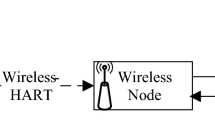Abstract
This paper presents an approach to estimate the remaining useful life of sensors. First, a system state machine is defined to divide the sampled data received from the sensors into different categories. Then, the sampled data sets are sent to the fault model to detect whether a fault has occurred. The time of occurrence for each type of fault is recorded and weighted with different coefficient. The weighted values are accumulated to form a trend data graph. An exponential curve fitting is then used to approximate the trend of data to determine the remaining useful life function and threshold is also generated from the cumulative faults value. The experimental results shows the proposed model has a precision of 66.67% and recall rate near 100% within 10-h timespan. Thus, the proposed model may not only prolong the life span of sensors, but may also reduce the cost to replace them.
Access this chapter
Tax calculation will be finalised at checkout
Purchases are for personal use only
Similar content being viewed by others
References
Ghasemi, A., Zahediasl, S.: Normality tests for statistical analysis: a guide for non-statisticians. Int. J. Clin. Endocrinol. Metab. 10(2), 486–489 (2012)
Smith, Z., Wells, C.: Central limit theorem and sample size. In: Annual meeting of the Northeastern Educational Research Association (2006)
Jarque, C., Bera, A.: Efficient tests for normality, homoscedasticity and serial independence of regression residuals. Econ. Lett. 6(3), 255–259 (1980)
Li, S.: Application of the internet of things technology in precision agriculture irrigation systems. In: International Conference on Computer Science and Service System (2012)
Cheng, T.: A critical discussion on bath-tub curve. In: Chinese Society for Quality (2006)
He, D., Bechhoefer, E., Ma, J., Li, R.: Particle filtering based gear prognostics using one-dimensional health index. In: 2011 Annual Conference of the Prognostics and Health Management Society (2011)
Li, Y.G., Nilkitsaranont, P.: Gas turbine performance prognostic for condition-based maintenance. Appl. Energy 86, 2152–2161 (2009)
Baljak, V., Tei, K., Honiden, S.: Fault classification and model learning from sensory readings—framework for fault tolerance in wireless sensor networks. In: Intelligent Sensors, IEEE Eighth International Conference on Sensor Networks and Information, pp. 408–413 (2013)
Wei, M., Chen, M., Zhou, D., Wan, W.: Remaining useful life prediction using a stochastic filtering model with multi-sensor information fusion. In: Prognostics and System Health Management Conference, pp. 1–6 (2011)
Overly, T., Park, G., Farinholt, K., Farrar, C.: Piezoelectric active-sensor diagnostics and validation using instantaneous baseline data. IEEE Sens. J. 9(11), 1414–1421 (2009)
Sharma, A., Golubchik, L., Govindan, R.: Sensor faults: detection methods and prevalence in real-world datasets. ACM Trans. Sens. Netw. 6(3), 23 (2010)
Acknowledgement
The authors would like to thank the Ministry of Science and Technology for supporting this research, which is part of the project numbered 103-2221-E-006-257-MY3, 104-2221-E-151-007-, 105-2221-E-151-034-MY2, and 105-2221-E-006-138-MY2.
Author information
Authors and Affiliations
Corresponding author
Editor information
Editors and Affiliations
Rights and permissions
Copyright information
© 2017 Springer International Publishing AG
About this paper
Cite this paper
Chai, FC., Lo, CC., Horng, MF., Kuo, YH. (2017). Remaining Useful Life Estimation-A Case Study on Soil Moisture Sensors. In: Nguyen, N., Tojo, S., Nguyen, L., Trawiński, B. (eds) Intelligent Information and Database Systems. ACIIDS 2017. Lecture Notes in Computer Science(), vol 10192. Springer, Cham. https://doi.org/10.1007/978-3-319-54430-4_32
Download citation
DOI: https://doi.org/10.1007/978-3-319-54430-4_32
Published:
Publisher Name: Springer, Cham
Print ISBN: 978-3-319-54429-8
Online ISBN: 978-3-319-54430-4
eBook Packages: Computer ScienceComputer Science (R0)




